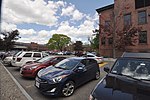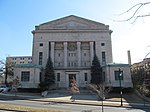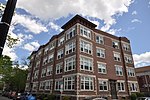High School of Commerce (Massachusetts)
High School of Commerce, also known as Springfield High School of Commerce, is a public high school in Springfield, Massachusetts. Enrollment is about 1,400 students. The school is at 415 State Street. It offers an International Baccalaureate program that about 15 percent of students pursue. Minority enrollment is 91 percent. It is one of six high schools in Springfield. The school's graduation rate was 59 percent and it fell below the district and state averages in testing. Of the students who participated in the IB program, 81 percent passed their IB exams. A majority of the student body is Hispanic.The school offers an ROTC program.In 2019 a student was arrested at the school after having words with the officer at the school. Video of the incident contradicted the officer's report that the student walked toward the officer after the comments were made, instead showing the officer approach the student who was walking away.Long-serving Agawam town clerk, Richard Theroux, became a teacher at the school after stepping down from office. Theroux was also fined $10,000 for violating Conflict of Interest law.
Excerpt from the Wikipedia article High School of Commerce (Massachusetts) (License: CC BY-SA 3.0, Authors).High School of Commerce (Massachusetts)
State Street, Springfield
Geographical coordinates (GPS) Address Phone number Nearby Places Show on map
Geographical coordinates (GPS)
| Latitude | Longitude |
|---|---|
| N 42.1065 ° | E -72.5784 ° |
Address
High School of Commerce
State Street 415
01105 Springfield
Massachusetts, United States
Open on Google Maps










